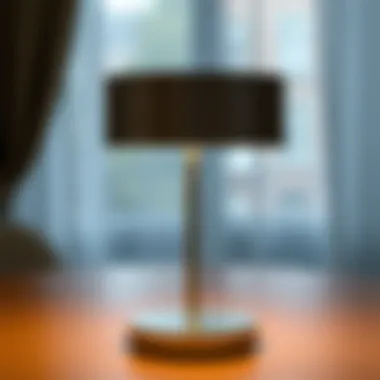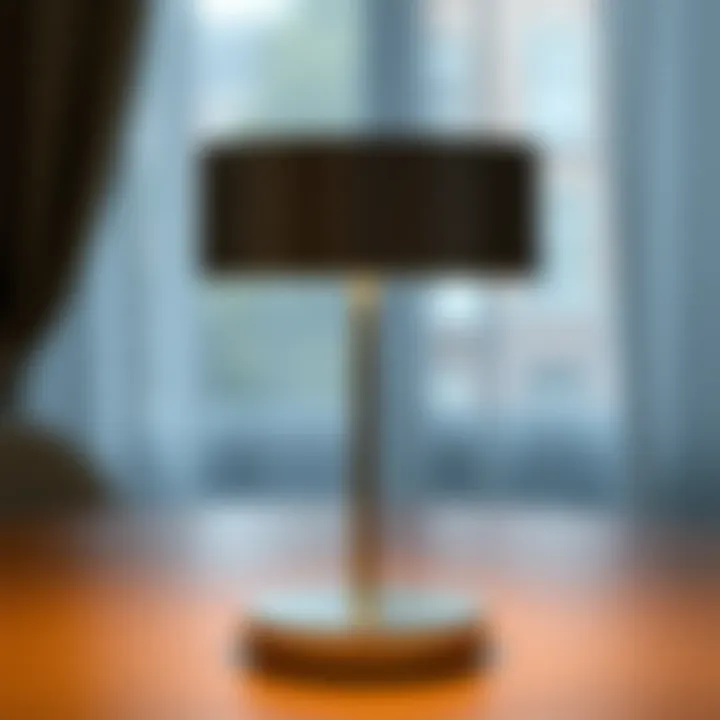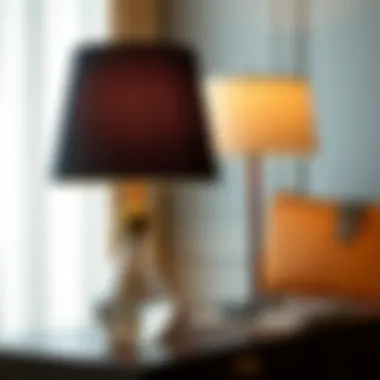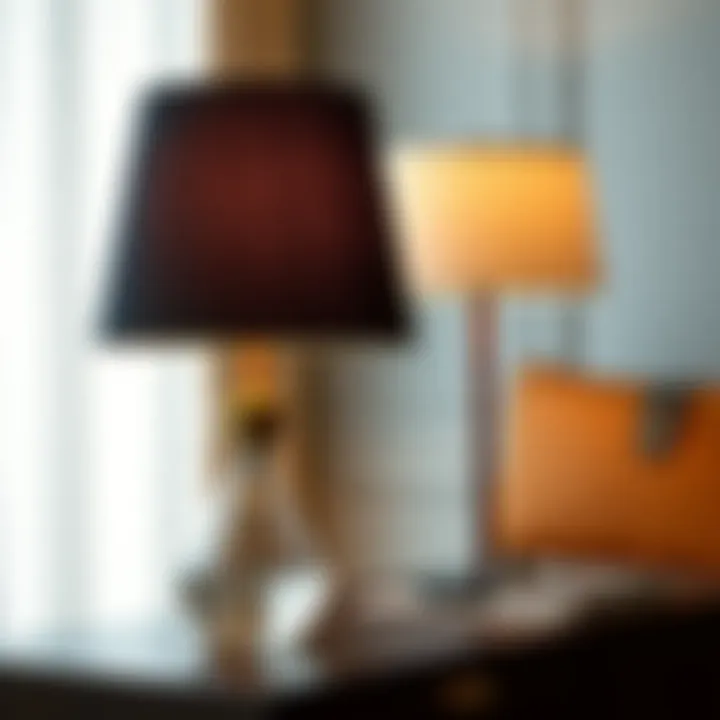The Beauty and Functionality of Shade-Free Table Lamps


Intro
Table lamps without shades might just be the unsung heroes of modern home decor. These fixtures don’t merely serve as sources of light; they become integral components of the design narrative within a space. From minimalistic lines to imaginative shapes, shade-less table lamps strike a balance between aesthetic appeal and functional lighting. As interior design trends evolve, these lamps offer versatile options for creating unique atmospheres, all while challenging traditional norms. Whether you’re a homeowner looking to revamp a room or a designer scouting fresh inspirations, understanding the nuances of these lamps is crucial.
Furniture Design Trends
Current Styles and Aesthetics
In a world where design choices proliferate, shade-less table lamps are laying down the law. Their silhouettes often echo the essence of contemporary art—sleek, stylish, and provocative. Think about geometric designs that offer a sense of structure or organic shapes that bring a touch of nature indoors. Designs often use a mix of materials, ranging from polished metals to raw ceramics, allowing each lamp to deliver a distinctive statement.
Form follows function in this scenario. These lamps not only illuminate spaces but also invite conversation. You’ve got striking designs like those by brands such as Flos and Muuto, which push the envelope by offering sculptural forms that resemble works of art. In contrast, you can find simpler, more utilitarian styles that resonate with the Minimalist movement, echoing an ethos of simplicity and purpose.
Color Palettes and Materials
When it comes to color and material, the options are as varied as they come. Neutral palettes often dominate, delivering a calm ambiance suitable for various settings. Soft whites, earthy tones, and greys easily marry with furniture, giving off a serene vibe. Yet, bold colors can equally shine in spaces, adding splashes of personality. For instance, a bright red or cobalt blue base brings energy and vibrancy to otherwise muted atmospheres.
Materials play an equally integral role. Metal finishes, like gold and brass, imbue spaces with luxury and sophistication, while matte ceramics offer a more rustic and homey feel. The use of glass in these designs introduces an element of elegance, often refracting light in ways that shimmer and dance around the room.
Buying Guides
Essential Considerations When Purchasing
Before diving headfirst into a purchase, it's wise to consider a few essential factors. Your main priorities should focus on:
- Size: Ensure that the lamp fits the intended space well. An oversized piece can overwhelm, while a diminutive one may vanish.
- Height: Consider the lamp's height, keeping in mind the height of surrounding furniture and intended use. A lamp that’s too tall can glare, while one that’s too short may not provide adequate lighting.
- Bulb Type: Certain lamps work better with specific bulbs. LED bulbs, for instance, produce less heat and consume less energy.
Top Recommendations for Different Budgets
Here’s a compilation of some enticing options available across various price ranges:
- Affordable: Brands such as IKEA offer stylish budget-friendly options that marry functionality with design.
- Mid-Range: Ferm Living and CB2 house stunning pieces that elevate a space without breaking the bank.
- High-End: Tom Dixon or Hay deliver luxurious designs that serve as centerpiece conversation starters in upscale interiors.
"Choosing the right table lamp can transform the mood of any room, making the lighting both functional and a part of the décor."
By understanding the aesthetic and functional dimensions of shade-less table lamps, one can make informed choices that enhance their environments. This knowledge not only enriches personal spaces but also nurtures a deeper appreciation for how lighting shapes our experiences at home. Nuanced decisions in design, material, and budget can lead to striking results, enabling the purposeful blending of light and art.
Understanding Table Lamps Without Shades
Table lamps without shades hold a unique place in the world of interior design. They combine aesthetic simplicity with functional elegance, making them a popular choice for modern homes and offices alike. This article seeks to elevate the understanding of these distinctive lighting fixtures by examining their characteristics, benefits, and practical applications. One might wonder why someone would opt for a lamp with no shade. The answer is multi-faceted, as these lamps offer a blend of style and substance.
When it comes to aesthetics, shade-less table lamps are a testament to minimalism. Their design puts the spotlight—literally and figuratively—on the materials and shapes themselves, making them artistic statements within a space. They often become focal points, drawing the eye and igniting conversation. Homeowners, designers, and DIY enthusiasts alike can appreciate how these lamps can transform a room’s ambience. The absence of a shade allows for unique shapes and forms, inviting creativity in their design.
So, what makes them functional?
Without a shade to diffuse the light, these lamps provide a more direct, focused source of illumination. This can be particularly beneficial in environments requiring concentrated lighting, such as study areas or workspaces. The ability to position the lamp strategically enhances its effectiveness and brings a certain versatility to various settings.
However, it’s important to consider a few factors when integrating shade-less lamps into a home. Potential glare is one such concern. Without a shade, the intensity of the light can overpower a room if not balanced correctly. Moreover, safety is also a critical aspect to take into account; ensuring lamps are not placed where they could be knocked over is crucial for maintaining a comfortable and secure environment.
Key Benefits of Shade-less Table Lamps:
- Artistic Expression: They offer a canvas for creativity in design, allowing unique artistic statements.
- Focused Lighting: Ideal for areas that require targeted illumination, enhancing functionality.
- Space Efficiency: Their often sleek design can make them fit into smaller or more cramped areas effectively.
- Eco-Friendly Choices: Many shade-less lamp designs capitalize on sustainable materials and energy-efficient bulbs.
The discussion of shade-less table lamps invites a deeper exploration of light’s tangible and intangible effects on spaces, illustrating the significant role they play in both aesthetics and utility. Learning how to integrate them thoughtfully into varied settings will be further explored in the sections that follow.
Design Principles Behind Shade-less Table Lamps
When it comes to shade-less table lamps, the design principles at play offer both aesthetic and functional coherence. These lamps not only illuminate spaces but also serve as statement pieces in their own right. Understanding these principles is crucial for interior designers, homeowners, and DIY enthusiasts, as they directly influence how these lamps can enhance or transform a space.


Minimalism and Aesthetic Appeal
Minimalism plays a pivotal role in the allure of shade-less lamps. By stripping away the traditional lampshade, the fixtures can showcase their inherent designs—be it geometric lines or organic shapes. This simplicity allows the light source itself to become the star of the show, harmonizing with various décor styles, from the industrial to the Scandinavian.
- Visual Clarity: Without shades, there is an unfiltered view of the bulb and everything it embodies, contributing to a clean visual line that often enhances the room's architectural features.
- Focal Point Creation: These lamps can establish a strong focal point. Picture a minimalist wooden base supporting an exposed Edison bulb, casting a warm glow that draws the eye.
- Balancing Elements: Light can play off of surrounding textures and colors, making it easier to maintain balance within a room's layout. When paired with richly textured items like woven baskets or textured walls, shade-less lamps can elevate the visual interest.
"Minimalist design invites both simplicity and complexity—it's the beauty of letting the lamp, in its most essential form, shine through."
Aesthetically, a shade-less lamp can serve as a conversation starter, a piece that encourages engagement with its unique design language, causing people to reconsider what a lamp can be. In addition, the laxer forms can draw attention effortlessly, often leading to an exploration of the surrounding furnishings and decorations.
Material and Form Considerations
The materials and forms utilized in shade-less table lamps are critical to their success in both function and aesthetics. Selecting the right combination can ensure a lamp performs well in terms of light distribution while being pleasing to the eye.
- Material Choices: Whether it’s metal, glass, or ceramics, the material significantly affects how well a lamp integrates into a room. For example, a brass finish can bring a touch of elegance and warmth, while a sleek, matte black can contribute to a more modern feel.
- Shape and Size: The form of these lamps—rounded, angular, tall, or short—affects not only alignment with other décor but also the quality of light produced. A taller lamp might distribute light more effectively across a greater area compared to a squat design.
- Finishes and Textures: The finish of the material can change how light interacts with the lamp itself and the surrounding environment. Reflective surfaces might enhance brightness, while textured finishes may diffuse the light creating a softer ambiance.
In summary, the principles of design in shade-less table lamps boil down to the essence of light and structure. It challenges conventionality by presenting a functional object as a work of art, blending utility with creativity. By leveraging minimalism, appropriate materials, and thoughtful design, these lamps can significantly uplift a space, inviting both practicality and artistic expression into home environments.
Functional Aspects of Shade-less Table Lamps
Shade-less table lamps bring to the table a unique combination of aesthetic charm and practical functionality. The clarity and transparency offered by these designs challenge conventional lighting norms. They maximize light exposure without the obstacles that shades can impose. With proper attention to detail, the functional aspects of these lamps enhance both the ambiance and usability of spaces.
Every homeowner or designer should consider how these lighting fixtures can influence various aspects of a room—from illumination quality to overall energy efficiency. Let's delve deeper into two primary functional aspects: light distribution and versatility in various settings.
Light Distribution and Efficacy
Without the confines of shades, shade-less lamps provide a direct flow of light that can illuminate a room more effectively. The absence of barriers means that the light source shines unfiltered, creating bright zones free from shadowy corners. This characteristic is particularly advantageous in spaces requiring focused lighting, such as desks or reading nooks.
When assessing the efficacy of light distribution, consider these points:
- Brightness Control: Many shade-less lamps utilize LED technology that allows for energy-efficient brightness while reducing heat emission.
- Directional Lighting: This design gives users the option to position the lamp to direct light effectively toward specific areas without the risk of shades absorbing some of that light.
- Layering Effects: Unlike traditional lamps, the nature of shade-less lamps complements other light sources in a room, allowing for a layered lighting effect.
"Designing with shade-less lamps is not just about illuminating space; it's about creating environments that enhance everyday experiences."
Versatility in Various Settings
Shade-less table lamps are like chameleons; they adapt gracefully to diverse environments. Their simple yet striking designs make them suitable for various settings—from contemporary living rooms to rustic kitchen counters. Unlike their shaded counterparts, shade-less lamps can easily fit into smaller spaces without visual clutter. This versatility extends to their functionality as well.
Consider the following scenarios:
- Workspaces: In an office setting, a shade-less lamp serves dual purposes: as a sculptural piece and as a bright, task-oriented light source that minimizes eye strain.
- Intimate Areas: When placed strategically in reading corners or beside a cozy chair, they provide enough light to create a warm, inviting atmosphere while remaining unobtrusive.
- Public Spaces: In cafes or galleries, shade-less lamps can blend seamlessly into sophisticated interior designs while providing necessary illumination for patrons or artwork.
The adaptability of shade-less lamps allows homeowners and designers to play with the configuration of light in a way that enhances the overall design of the space. It broadens the possibilities of decor choices, making each decision a step towards curating a specific vibe that suits one's lifestyle.
With these functional aspects at the forefront, it’s clear that shade-less table lamps can significantly shape the way we perceive lighting in our homes. The light they distribute and their incredible flexibility in design help cultivate spaces that are both functional and visually appealing.
Current Trends in Table Lamp Design
In the realm of interior aesthetics, table lamps without shades are carving out a niche that blends artistry and functionality. These designs often become conversation starters, captivating attention while providing essential lighting. As trends evolve, so do the approaches and innovations in lamp design. This section sheds light (pun intended) on two significant currents shaping the world of shade-less table lamps—eco-friendliness and technological advancements.
Eco-Friendly and Sustainable Choices
Sustainability has shifted from being an afterthought to a central pillar in design philosophy. Here are some aspects that exemplify how eco-conscious approaches influence shade-less table lamp designs:
- Material Selection: A growing number of designers are opting for reclaimed wood, recycled metals, and sustainable plastics. These materials not only reduce waste but also bring unique textures and stories to each piece. Imagine a table lamp crafted from salvaged driftwood, its twisted form whispering tales of sea voyages.
- Energy-Efficient Lighting: LED bulbs have taken center stage in eco-friendly lighting. They consume significantly less energy compared to incandescent bulbs while boasting a longer lifespan. Incorporating LEDs transcends mere utility; it aligns with a lifestyle choice toward lower carbon footprints.
- Local Sourcing: Many artists and manufacturers are leaning towards local sourcing of materials, which helps to reduce transportation emissions. Supporting local craftsmen not only honors community ties but also often results in distinct, culturally infused designs that carry an artisanal touch.
"Purchasing a home accent is more than just decor; it embodies values and lifestyle choices that can have lasting impacts on our planet."
Innovative Technologies and Features


As technology continues to advance at breakneck speed, table lamps without shades embrace various innovations that redefine accessibility and functionality. Here’s how these modern marvels are changing the landscape:
- Smart Capabilties: Many shade-less lamps now come equipped with smart technology, allowing users to control brightness, color temperature, and even schedules through apps or voice commands. Picture coming home after a long day, and with a simple command, your lamp brightens to welcome you.
- Adaptive Lighting: Some lamps are now designed to adapt lighting based on the time of day or the predominant colors in the room. Such adaptability ensures that the ambiance remains cozy and inviting, enhancing the overall aesthetic without compromising functionality.
- Wireless Charging Features: Integrating wireless charging pads into lamp bases is an emerging trend that marries convenience with sleek design. This feature eliminates the clutter of multiple cords, keeping your space tidy while ensuring your devices are always powered up.
The embrace of these trends illustrates that shade-less table lamps are more than just a light source. They represent a blend of sustainable living and technological progress, making a statement in both style and practical application. Homeowners, designers, and DIY enthusiasts alike can find endless possibilities in these evolving designs, enriching their spaces visually and functionally.
Incorporating Shade-less Lamps into Home écor
Integrating shade-less lamps into your home decor can transform the ambient atmosphere of your space. The essence of these fixtures lies in their stark elegance and versatility, offering both illumination and artistic expression. Unlike traditional lamp designs that may get lost in the shuffle of furnishings, shade-less lamps stand out; they act as sculptural elements while complementing other design features. This section explores the significance of employing shade-less lamps within interior spaces, highlighting benefits and crafting considerations integral to modern aesthetics.
Designing with Contrast
When considering shade-less lamps, embracing the principle of contrast can lead to visually arresting designs. This approach revolves around juxtaposing various elements, from texture to color. For instance, a sleek glass lamp can provide a striking contrast against a rustic wooden table. The interplay of materials not only enhances visual intrigue but also invites an emotional response.
To effectively use contrast:
- Color Play: Pair a white or metallic lamp with dark furniture. The stark difference can create a focal point that engages the eye effectively.
- Material Mix: Mix materials like ceramic, glass, or metal. Each material brings its own character, enriching the overall look.
- Shape and Form: Combining varied silhouettes, such as a round lamp on a square table, adds dynamism to the arrangement.
By thoughtfully placing shade-less lamps amidst varied textures and colors, you cultivate an environment that feels layered and considered. A balance of lightness and weight, darkness and brightness can lead to a harmonious design narrative that breathes life into your room.
Creating Focal Points in Spaces
Incorporating shade-less lamps also serves a critical function: they can act as focal points around which conversations and interactions revolve. Positioning these lamps strategically can draw attention to specific areas, enhancing both aesthetics and functionality.
To craft impactful focal points:
- Placement: Position the lamp where it can naturally attract attention, like an end table near a sofa or a console table in an entryway.
- Height Variation: Consider taller designs that catch the eye or create a series of varying heights for added interest. For example, a tall gradient lamp can command attention while a smaller lamp complements it nearby.
- Color and Illumination: Choose colors that resonate with the room's palette but also stand apart enough to catch the eye. Warm light can draw people to a cozy nook, while cool light can open up darker spaces.
In the grand design scheme, shade-less lamps contribute to the overall atmosphere while marking out areas intended for relaxation or activity. They enrich interiors and play a vital role in expressing personal style through thoughtful place ment and design.
Challenges of Shade-less Lighting
When it comes to lighting solutions in contemporary homes, shade-less table lamps have steadily made their mark. However,, they also bring along a basket of challenges that both homeowners and designers must navigate. These challenges primarily revolve around glare, brightness, safety, and practicality. Understanding these issues not only helps in making informed design decisions but also enhances user experience.
Managing Glare and Brightness
One of the foremost challenges with shade-less table lamps is managing glare. Without a shade to diffuse the light, bulbs—especially those with higher lumens—can produce an intense, direct illumination that some might find overwhelming. It's a bit like trying to enjoy a good book under a glaring sun; just not comfortable at all. Here are some key factors to consider:
- Brightness Intensity: High-intensity bulbs can produce light that is harsh on the eyes. One simple solution is opting for adjustable illumination where a dimmer switch can help manage the lamp’s output.
- Positioning: The placement of the lamp also plays a crucial role. Placing lamps at appropriate heights and angles can minimize direct glare that can be distracting or uncomfortable.
- Variability of Bulbs: Considering different types of bulbs can help mitigate brightness issues. For instance, LED bulbs come in various color temperatures, offering softer options that may not induce glare.
To sum up, effective glare and brightness management is essential for a harmonious lighting experience. Using bulbs with proper lumens, adjusting positioning, and incorporating dimmers can transform how shade-less lamps function in your space.
Safety and Practical Considerations
The safety considerations surrounding shade-less table lamps are another key area of focus. While they contribute to a sleek and modern aesthetic, their functionality doesn’t come without risks if not handled correctly:
- Heat Emission: Certain bulb types, like incandescent and halogen, can generate considerable heat. This raises concerns about their proximity to flammable materials. It's wonderful to admire a beautifully designed lamp but ensuring it doesn't end up becoming a fire hazard is essential.
- Stability: Unshaded lamps may be more prone to tipping over compared to their shaded counterparts. Choosing a sturdy base and ensuring that the lamp is placed on solid surfaces can help mitigate this issue, making them safer around pets and children.
- Cord Management: Properly managing cords plays a significant role in avoiding tripping hazards. Ensuring that cords are tucked away or used with cord covers can prevent accidents, especially in spaces frequented by children or guests.
In order to fully enjoy the aesthetic appeal of shade-less table lamps, it’s vital to address both glare and safety. Balancing form and function will ensure that these lamps enhance your home, rather than pose risks.
Maintenance and Care for Shade-less Table Lamps
Keeping shade-less table lamps looking their best goes beyond mere aesthetics. The nature of these designs means that every component is often on full display. With this in mind, maintenance becomes crucial in ensuring their effectiveness and longevity. By taking proper care of these lamps, homeowners can preserve their beauty, enhance their functionality, and avoid unsightly wear and tear.
A well-maintained table lamp not only serves its purpose but also acts as a statement piece. As they stand often at eye-level, any dust or grime that accumulates can zap the elegance right out of the room. Moreover, the materials used can be sensitive, requiring differing levels of attention to keep them shining like new.
Cleaning and Upkeep Strategies
To maintain the allure and functionality of shade-less table lamps, adopting fool-proof cleaning strategies is vital. Here are some recommendations:


- Dust Regularly: Use a microfiber cloth at least once a week to gently wipe down the lamp. This prevents a build-up of dust and helps keep surfaces clean.
- Wipe with Mild Cleaners: If the lamp needs more than a light dusting, opt for a mild soap mixed with warm water. Avoid abrasive materials that can scratch the surface. Dampen the cloth and ensure not to soak the lamp itself.
- Check the Wiring: While cleaning, inspect the exposed wiring for any signs of wear or damage. If anything seems off, it might be best to seek professional advice.
- Polishing Metals: If the lamp boasts metallic elements, a suitable metal polish can enhance their shine. Just remember to follow the instructions carefully.
Taking these steps can significantly enhance the lifespan of shade-less lamps. Neglecting maintenance can lead to loss of charm, and worse, it could negatively impact the safety functions of electrical components.
Assessing Durability of Materials
Understanding the durability of materials used in shade-less lamps is essential for effective maintenance. Different materials respond uniquely to cleaning and normal wear. Here’s what to keep in mind:
- Glass: This material is often quite beautiful but susceptible to chips and cracks. Use it with care when cleaning.
- Metal: Metals can be hardy but may rust or tarnish if not properly cared for. Simple waxing or polishing at intervals can keep them looking fresh.
- Wood: While wood adds warmth and texture, it can be sensitive to moisture and heat. A simple dusting might be enough, and occasional polishing can maintain its luster.
"Durability often reflects how well materials can withstand the test of time, which is crucial for items that hold as much aesthetic value as practical application."
- Ceramics and Stone: These can be beautiful choices but may chip easily. Avoid using heavy-handed cleaning methods here as well.
Assessing the durability of materials isn't just about cleaning; it fundamentally involves understanding how each one reacts to both daily use and environmental factors. Taking the time to evaluate how materials age can make a world of difference in the longevity and appearance of your shade-less table lamps.
DIY Approaches to Creating Shade-less Table Lamps
Creating shade-less table lamps can be a rewarding endeavor for DIY enthusiasts and homeowners alike. This endeavor not only allows for personal expression but also offers practical benefits. When you craft your own lamps, you have complete control over the design, materials, and functionality. This customization means that your finished product can perfectly align with your aesthetic preferences and lighting needs.
In this section, we will explore how to choose materials effectively for your lamp project and provide a detailed crafting guide that takes you through the process step-by-step. Whether you're a seasoned DIYer or just venturing into the realm of home projects, the following information will be invaluable.
Selecting Suitable Materials
Choosing the right materials is crucial when creating a shade-less table lamp. The materials not only influence the lamp's durability but also its overall look and feel. Here are some key components to consider:
- Base Material: Selecting a sturdy base material is paramount. Options such as wood, metal, and ceramic offer different aesthetic appeals. For example, a wooden base can impart a warm, rustic feel, while a polished metal base can add a modern touch.
- Light Source: You must consider the type of light bulb your lamp will use. LED bulbs are popular for their energy efficiency and longevity, while vintage-style incandescent bulbs can provide a nostalgic glow. Choose the wattage according to the lamp's placement – brighter bulbs for work areas and softer ones for ambient lighting.
- Wiring Components: Ensure you select quality wiring components to guarantee safety. You will need a socket, a switch, and appropriate electrical wiring. Using certified electrical parts is vital to avoid any fire hazards.
- Decorative Elements: While shade-less lamps may appear minimalist, you can still incorporate decorative elements like colorful cords, painted bases, or metallic finishes. These details can infuse personality into your design.
Step-by-Step Crafting Guide
Making your own shade-less table lamp involves several straightforward steps that can be completed with basic tools and materials. Here’s a step-by-step guide:
- Gather Your Materials: Collect all selected materials – base, bulb, socket, switch, wires, and any decorative items you want to include.
- Prepare the Base: If you're using wood, you may want to sand it down to achieve a smooth finish. Paint or stain it to match your decor if desired. If using metal or ceramic, ensure it is clean and dry before moving forward.
- Assemble the Socket: Use a drill to create a hole in the base for the socket. Insert the socket and secure it in place.
- Wire the Lamp: Carefully connect the wiring to the socket per the manufacturer's instructions. When wiring, it's vital to ensure that all connections are secure and insulated to prevent accidents.
- Install the Switch: Depending on the design of your lamp, you may want to place the switch inline with the cord or as a part of the base. Follow the product guidelines to ensure correct installation.
- Attach the Bulb: Screw in your chosen light bulb. Check the wattage to ensure it does not exceed the socket's maximum rating.
- Test the Lamp: Plug in the lamp and operate the switch to ensure everything works correctly. Inspect for any issues, like flickering or overheating.
- Final Touches: Add any final decorative elements you desire, such as a unique cord wrap or a custom-painted base, to personalize your lamp.
Creating a shade-less lamp can offer not only a practical lighting solution but also gives you a unique piece of decor. As you engage in this project, embrace the creativity that comes with DIY, and take pride in the personal touch your lamp now brings to your space.
Future Directions in Shade-less Lamp Design
The exploration of shade-less lamps isn't just a fleeting trend—it's reflective of deeper shifts in design philosophies and consumer needs. As a marriage of functionality and artistic expression, shade-less table lamps are gaining ground in the realm of interior decor. Their future lies in a confluence of innovation, user engagement, and eco-conscious design, providing a canvas for both creators and consumers.
Emerging Trends and Innovations
The future of shade-less table lamps is bright, pun intended. We're seeing a vigorous embrace of smart technology in lighting design. Imagine controlling your lamp’s brightness via an app or having it sync with your daily rhythms. These innovations aren't just about convenience; they’re about enhancing the atmospheric quality of spaces. Color-changing LEDs, for instance, are becoming commonplace, allowing homeowners to tailor the lighting based on mood or time of day.
Some notable trends include:
- Smart Integration: More and more models are coming out with Wi-Fi connectivity, allowing for voice activation and remote management.
- Sustainable Materials: Expect to see more lamps crafted from recycled or readily replenishable materials. This aligns with broader trends in sustainability, catering to an environmentally-conscious audience.
- Modular Designs: Innovation in design often leads to modular pieces that can be customized or expanded upon according to personal taste or space needs.
Aesthetic flexibility is another key feature emerging in these designs. With sleek lines and organic shapes, the next wave of shade-less lamps can blend effortlessly into any environment, be it minimalist, eclectic, or industrial.
The Role of User Preferences in Design Evolution
Design is an ever-evolving conversation between creators and users. As consumer preferences shift, designers must respond with solutions that are not only functional but also resonate on a personal level. With shade-less lamps, the nuances of user interaction—how people engage with light—are forming the future of these designs.
Consumers today are increasingly inclined towards pieces that reflect their individuality, fostering a demand for lamps that serve as both functional objects and personal statements. This desire for personalization is steering designers toward making lamps that are customizable in terms of color, form, and even interaction.
Factors influencing these shifts include:
- Aesthetic Preferences: Consumers are searching for pieces that resonate with their personal style, prompting a rise in artisan and handcrafted designs.
- Tech-savvy Collaboration: Users, especially younger demographics, thrive on interactivity, leading manufacturers to explore partnerships with tech firms to create innovative products.
- Community Feedback: Platforms like Reddit and Facebook groups are increasingly shaping design trends, as creators actively seek insights and suggestions from users, understanding their needs firsthand.
In the broader context of home decor, shade-less lamps will likely continue to serve as both a practical necessity and a piece of artistry, embodying the desire for illumination that feels personal and relevant to individual lifestyles.
"As design evolves, it's essential to consider not just what lamps do, but how they make us feel about our spaces."
In sum, the future of shade-less lamp design looks to be a fascinating blend of technology, personalization, and sustainability, aligning with the tastes and preferences of modern users while paving the way for innovative lighting solutions.















